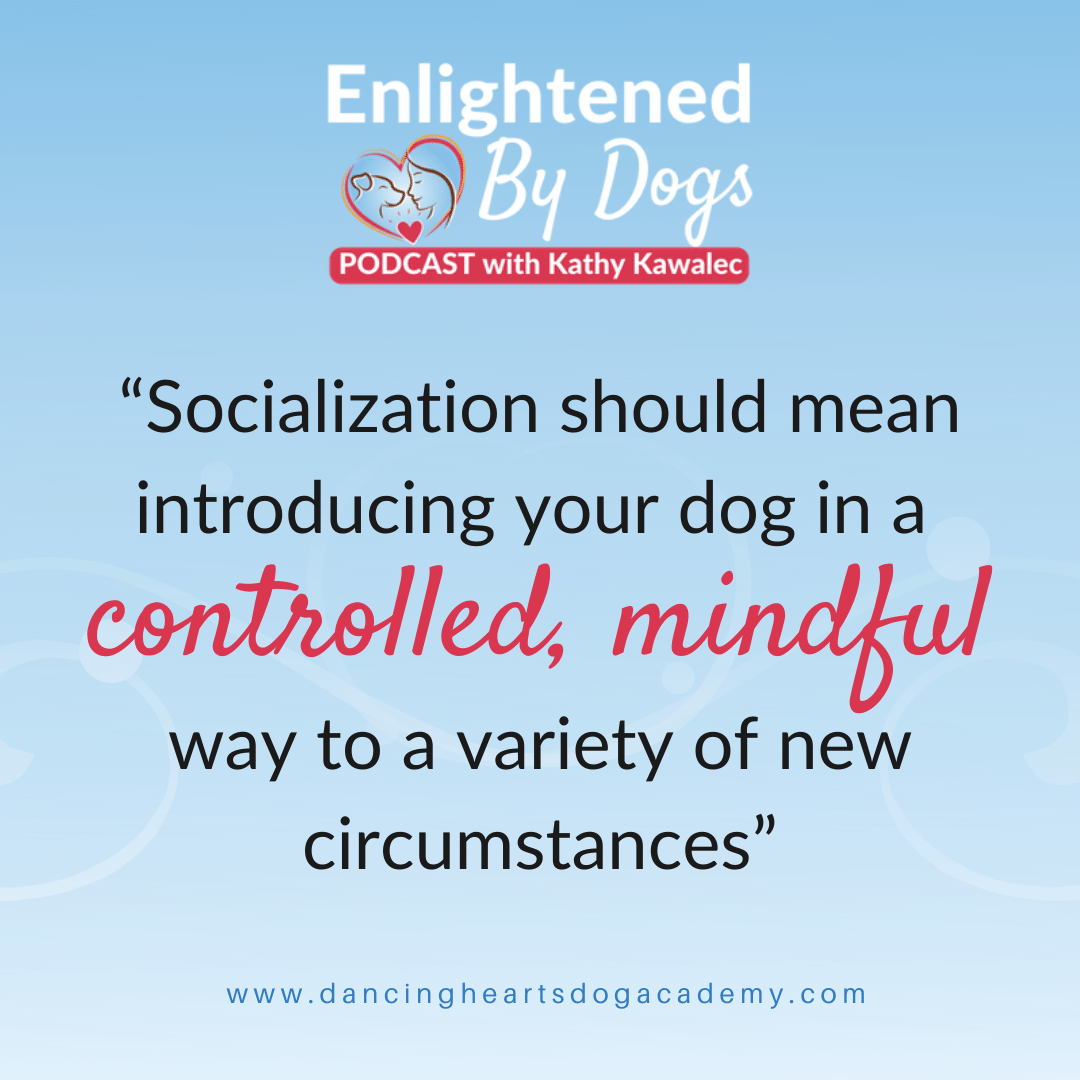There are so many theories of how socializing dogs should be done. However, some of these methods might not be right for your dog. In fact, there are three common socialization myths that I want you to be aware of.
In this post, I’m going to share these myths with you and explain why attempting to socialize your dog in any of these ways could be a mistake.
How to properly socialize your dog
Socialization is key to your dog’s development – no matter what age they are. But if you have a puppy, the world is a whole new place. Socializing your dog can help them learn more about the world and understand their place in it. But only when you approach it the right way.
So, how can you effectively socialize your dog or puppy? The best method is to introduce your dog to a variety of new things (people, sounds, environments, etc.) in a controlled and mindful way while making sure that your dog feels safe, calm, and happy about the entire experience.
When socialization is done the right way, your dog will develop confidence, trust, resilience, and coping skills that will help them throughout their life. It’ll also boost the confidence you both have in your partnership. So, socializing correctly is really important!
But I want you to be mindful of falling into the socialization traps. So, here are three ways you should not socialize your dog.
Myth #1: Exposure is not positive socialization
The key to effective socialization is when your dog creates a positive association with that experience. This way, when they face similar situations in the future, they can be calm about the experience, and handle it in stride.
However, if your dog creates a negative association it can lead to long-lasting fear that is difficult to change.
It’s important to note that puppies can be hypersensitive to new experiences, especially if they are in what is sometimes called a ‘fear period’ and is more accurately a ‘sensitive period’. Even if a puppy has been happy with a particular experience in the past, during a sensitive period, the same experience can lead to a strong and long lasting negative association. So, paying attention to how your puppy is feeling in the moment is vital to ensuring positive socialization.
Ultimately, you want to give your dog the freedom to choose. Your dog will communicate when they’re ready to lean in and explore a new situation, but they’ll also tell you when they want to move away from it. Giving them their agency and allowing them control over their decisions will help them feel more positive about their experience.
I find this really interesting: It’s only when we intervene and try to “make it a positive experience” that socialization is more likely to have the opposite effect and backfires. But by trusting your dog and letting them make their own choice, it could be better for them and your partnership!
“Letting your dog have the freedom to choose if and how they want to get involved will lead to greater trust, greater confidence, and greater resiliency.”
Myth #2: Flooding is not positive socialization
Flooding is when you repeatedly immerse your dog in a fearful situation. This myth stems from the hope that your dog will have no choice but to face their fears and move past them. But there’s a lot wrong with this.
Often people who attempt to socialize their dog in this way will use tasty treats, toys, or praise to distract their dog from the discomfort and fear their dog is actually feeling. In the moment, it might seem as if your dog is ‘handling’ the experience because it appears as if they are focused on treats or a game.
However, this strategy doesn’t mitigate the fact that you’re dismissing your dog’s true feelings, which will become apparent as soon as the treats or play stops. And ultimately, this strategy is damaging the relationship with your dog as well as their trust, confidence, and resilience.
Think about it this way. If you had a fear of snakes, and your friend thought it was time to help you ‘get used’ to snakes which they deem to be harmless … and so took you into a room filled with snakes, how would you react? How comfortable would you be starting at the edge of the room and working your way further in while your friend gave you chocolates and praised you for being brave? Even if you accepted the chocolates, would you still be scared and wishing you weren’t there?
The reality is that your fear will probably send you into a shutdown. You might appear to be ‘calm’ to your friend because you’re not freaking out … but your nervous system has gone into survival mode, and without realizing it yourself, you are basically hoping to stay alive.
It’s the same for your dog. This might look like an obvious emotional and mental meltdown where your dog retreats into him or herself as a protection mechanism … or it might be much less obvious and look more like ‘calm’. Think about the long term effects: Will this build trust, confidence, and resilience? Not a chance!
Instead of flooding, think about the safe, calm, and happy protocol. This is what’s going to strengthen your partnership and open the doors to your dog embracing new experiences without your direct intervention. I call this the “sideways approach.”
“Socialize your dogs by NOT putting them into circumstances that make them uncomfortable, nervous, and are unnatural for them.”
Myth #3: Social pressure to conform is not positive socialization
This is a tough one. There’s a lot of pressure socially, from our peers, and more generally through cultural conditioning to get your dog to conform or behave a certain way.
But I think this is crazy! Your dog is unique and beautiful with their own personality and quirks. When we honor this, we recognize that our dogs are perfect in their imperfections. Just like we are.
Your dog’s breed can influence how they react to social pressure. For example, some types of dogs were selectively bred to NOT be overtly social with other dogs and strangers for a good reason.
Most dog breeds originally had a working purpose.
Think about it, your dog may have been bred to ignore outside stimuli and to only focus on a task at hand – that might mean ‘ignoring’ you, while your dog is busy doing what they perceive as their ‘job’. A herding breed dog wouldn’t abandon their sheep to go and play with a random dog who’s just showed up!
But breed is just one factor. Your dog’s personality type will also give you an indication of their character and how they’ll respond to social pressure. Is your dog an introvert or extrovert, for example? Some dogs are more outgoing and friendly, while others are by nature quieter and more reserved.
Honoring your dog by not putting them into circumstances that are unnatural and uncomfortable for them will be far better for their development than forcing them into a situation they’re not happy with…for the sake of ‘conformity’ and misplaced beliefs that all dogs ‘should’ behave in a certain way.
This will lead to leaking trust and confidence…and a dog that is communicating their discomfort with their ‘loud’ behavior.
Positive and proper socialization means that we honor our dogs breed, character, emotions, and that we don’t dismiss or try to distract our dog in order to live up to unrealistic social expectations.
By building your partnership from a place of non-judgement and unconditional love, you can help your dog develop trust, confidence, and resilience.
That trust, confidence and resilience is what will lead to your dog being able to calmly move through ordinary life experiences, while feeling safe, calm and happy!!
If you’d like to work with me and learn how to create a partnership lifestyle for you and your dog, you can request an invitation to join us in the Brilliant Partners Academy when the doors open for the next enrollment!
You can listen to everything I talked about in this blog post over on my podcast – Enlightened By Dogs. It’s episode 149, which you can listen to here.







2 Responses
Thank you this is so helpful I have pressure from certain people to socialize my dog and she is a sensitive herder type , rescued from wild dogs she gets along in her own time with dogs that come to visit but not out in public with strangers and that limits where I take her…. we have a big yard and I have settled to just keep her home accept for an occasional car ride…..the vet is my next challenge cover didn’t help… but your talks do. thanks again
It seems like my dog wants to meet every dog she sees. In fact she almost insists. However most of the time when she gets to the other dog she will bark and sometimes lunge aggressively which is not at all safe calm happy greeting. I avoid busy times and a places as much as possible. Use a quick u turn that is not always effective . am I breaking trust by not allowing her to go see the dog when she’s pulling me towards them? What’s the best way to handle this?